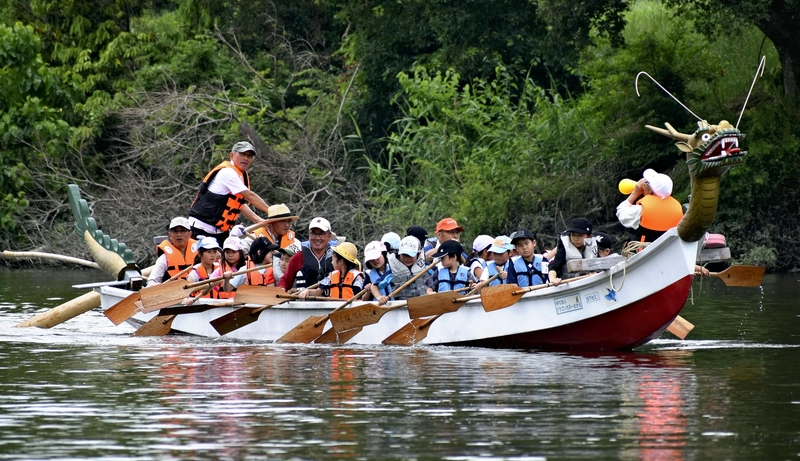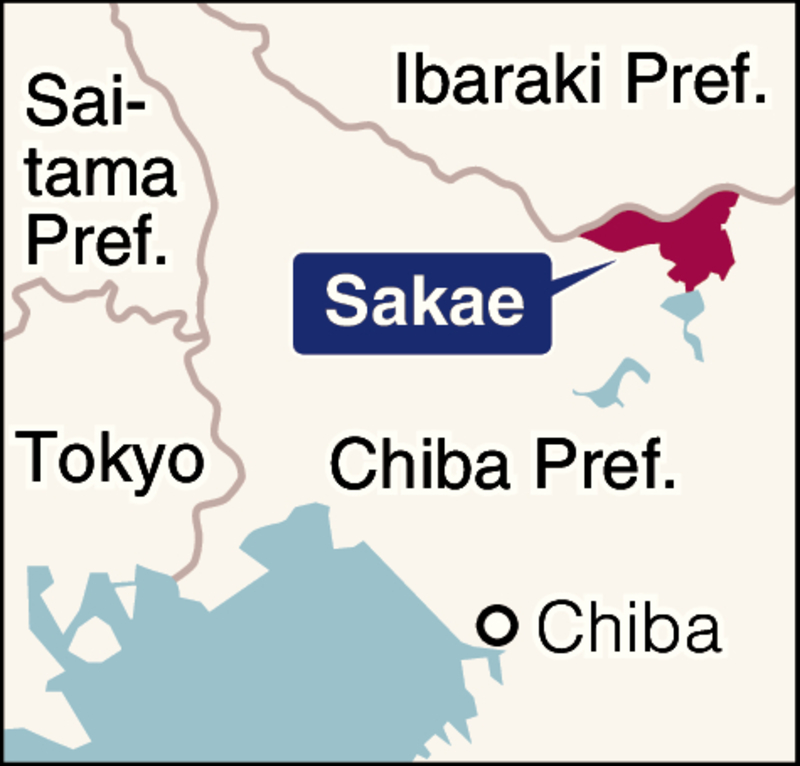
SAKAE, Chiba -- "Dragon canoes" ply the rivers of Sakae, Chiba Prefecture, allowing many people to enjoy the kind of waterfront scenery the town is known for.
Located west of the city of Narita and flanked by Tone River and the Inbanuma lake, Sakae is known as a town of waterfronts. The dragon canoes, a type of rowing boat that originated in China, were introduced in 2010 in connection with a local legend: Long ago, a small dragon -- the master of the Inbanuma lake -- is said to have sacrificed himself when the area was hit by a serious drought, thereby making it rain for seven days and seven nights.
In gratitude to the dragon, the villagers enshrined his head at a nearby temple, which was renamed Ryukakuji, or dragon horn temple.

The canoes are decorated with a dragon's head at the bow and a tail at the stern. The nonprofit organization Dragon Canoe Sakae operates the service on the Nagato and Shogen rivers that run through the town.
There are three dragon canoes, each with a capacity of 30 people. They are used for rowing programs that allow the participants to enjoy teamwork and waterfront scenery.
The paid service is available about three days a month from April to October. in 2019, about 220 people from Sakae and elsewhere rowed the canoes.
In a nature hands-on program for elementary school students in June 2019, about 40 children from the town set out on two boats. Masatomi Shinohara, 87, of the NPO, cheered them on, saying: "You guys, put your hearts together. Row, row." The boat picked up speed.
Common kingfishers fly over the water and grey mullets splash. People can enjoy seasonal scenery while canoeing: cherry blooms in spring and green foliage in summer.
"A dragon canoe is one of the best ways to enjoy Sakae," said Keiichi Kitamura, 73, the director of the NPO. "Elderly groups and foreign students have also enjoyed it."
The number of new residents in Sakae started to increase in the 1980s and ultimately became the majority of the town, as it is located within commuting distance of Tokyo. New residents started to participate in community volunteer activities, so the municipal government also began supporting such activities in the 2000s.
The origin of Sakae's dragon canoes dates back to 2009, which marked 1,300 years since the establishment of the Ryukakuji temple. A group of townspeople decided to organize a dragon canoe race to commemorate the occasion and to that end, they visited the city of Susaki, Kochi Prefecture, where dragon canoes have been used to invigorate the city.
A former high school teacher who can build canoes donated one, and Shinohara and other Sakae residents established an organization to accept the donation. This organization ultimately became the Dragon Canoe Sakae.
Ten years have passed since the start of the dragon canoeing service, but racing events have not been held for such reasons as not being able to secure space to build spectator stands. The NPO is also facing the challenge of recruiting young participants, as its members are aging. The youngest is now in his late 60s.
On Nov. 9 last year, after the canoeing season ended, about 10 people, including members of the NPO, put the boats in a storage house for maintenance. They also cleaned up the dock.
Kitamura hopes more people will engage in the NPO's activities. "I want to promote dragon canoeing that can create unity among various people, as a key tool for vitalizing our town," he said.
Dragon canoe events
Various dragon canoe events are held to invigorate communities across the country. In Aioi, Hyogo Prefecture, the Peron Festival is held annually in May. Dragon canoes are called peron in Aioi because they were first introduced by that name by shipyard workers from Nagasaki during the Taisho era (1912-1926).
Last year, about 2,400 people participated on 65 teams from around the country. The Aioi Peron Society, which consists of participating teams and others, organizes various paid events such as boat riding programs and rowing lessons to promote dragon canoes.
The city of Susaki, which hosted the canoeing competitions of the 2002 national sports festival, started a dragon canoe event in 1999 in cooperation with the city of Aioi. The two cities concluded an exchange agreement in 2005, and each provides a mayoral cup for the other's event.
-- Popular movie location
Sakae is located in northern Chiba Prefecture. With Tone River to the north and the Inbanuma lake to the south, it measures roughly five kilometers from north to south and 12 kilometers from east to west. The population was 20,535 as of Nov. 1, 2019.
The town is about 10 kilometers from Narita Airport and 50 kilometers from central Tokyo, with many of its residents working at the airport or in Tokyo.
The town's signature agricultural products are black soy beans called "dora mame," and rice farming is also popular. The prefectural Boso-no-Mura open-air museum is a major tourist spot. Its reproduction of an Edo-period town street with shops and old farmhouses is often used as a movie location.
Read more from The Japan News at https://japannews.yomiuri.co.jp/







